Sind Thunderbolt und USB-C dasselbe?
Mit der Allgegenwärtigkeit von USB-C kann man es buchstäblich auf fast jedem Gerät finden, außer dem iPhone, das immer noch bei Lightning bleibt. Diejenigen Nutzer, die mit iPad und MacBook vertraut sind, werden auch feststellen, dass die neuesten Versionen von iPad und MacBook bereits mit USB-C-Anschlüssen ausgestattet sind. Die MacBook-Reihe von 2016 bis 2020 ging sogar so weit, alle Anschlüsse außer USB-C zu eliminieren!

(MacBook Pro 15 Zoll, 2016, vier Thunderbolt 3-Anschlüsse.)
Der USB-C-Anschluss des MacBook ist jedoch kein gewöhnlicher USB-C-Anschluss. Es handelt sich um Thunderbolt 3, einen extrem leistungsstarken Anschluss. Viele fragen sich, ob der Thunderbolt 3-Anschluss ein USB-C-Anschluss ist. Wenn man bedenkt, dass das USB-C-Kabel mit demselben Anschluss funktioniert und beide die gleiche Form haben, was genau ist dann Thunderbolt 3?
Um es vorweg zu nehmen: Es gibt einen RIESIGEN Unterschied
- Ein Thunderbolt 3-Anschluss ist auch ein USB-C-Anschluss, da Thunderbolt 3 einen USB-C-Anschluss verwendet.
- Ein USB-C-Anschluss unterstützt jedoch nicht unbedingt Thunderbolt 3.
- Mit anderen Worten: Sie können Thunderbolt-Kabel an USB-C-Geräten verwenden. Allerdings unterstützt nicht jedes Gerät mit USB-C-Anschlüssen Thunderbolt 3-Kabel.
Wie wir bereits in einem früheren Artikel erwähnt haben, gibt es USB-Anschlüsse in verschiedenen Formen, und USB-C ist nur eine von ihnen. Der Name "USB-C" bezieht sich einfach auf die Form dieses Anschlusses.
USB-Stecker werden jedoch nicht nur nach ihrer Form kategorisiert und unterschieden. Sie können auch mit verschiedenen Protokollen geladen werden, die es der Schnittstelle ermöglichen, eine Vielzahl von Funktionen auszuführen. Wenn Sie ein USB-C-Kabel kaufen, werden Sie in der Regel die Bezeichnungen "USB 3.0", "USB 2.0" und "Thunderbolt" sehen, die alle unterschiedliche Protokollbezeichnungen sind.
Was ist so exquisit und besonders an Thunderbolt 3? Genau wie viele andere USB-Protokolle hat es sich über mehrere Generationen hinweg entwickelt. Am Anfang wurde kein USB-C-Anschluss verwendet.
Thunderbolt: Ausschließlich für Leistung gebaut
Die MacBook-Iteration gibt einen Einblick in die Entwicklung von Thunderbolt - obwohl Intel bei der Entwicklung von Thunderbolt führend war, hat auch Apple sein Bestes getan, um diese spezielle Technologie zu fördern.
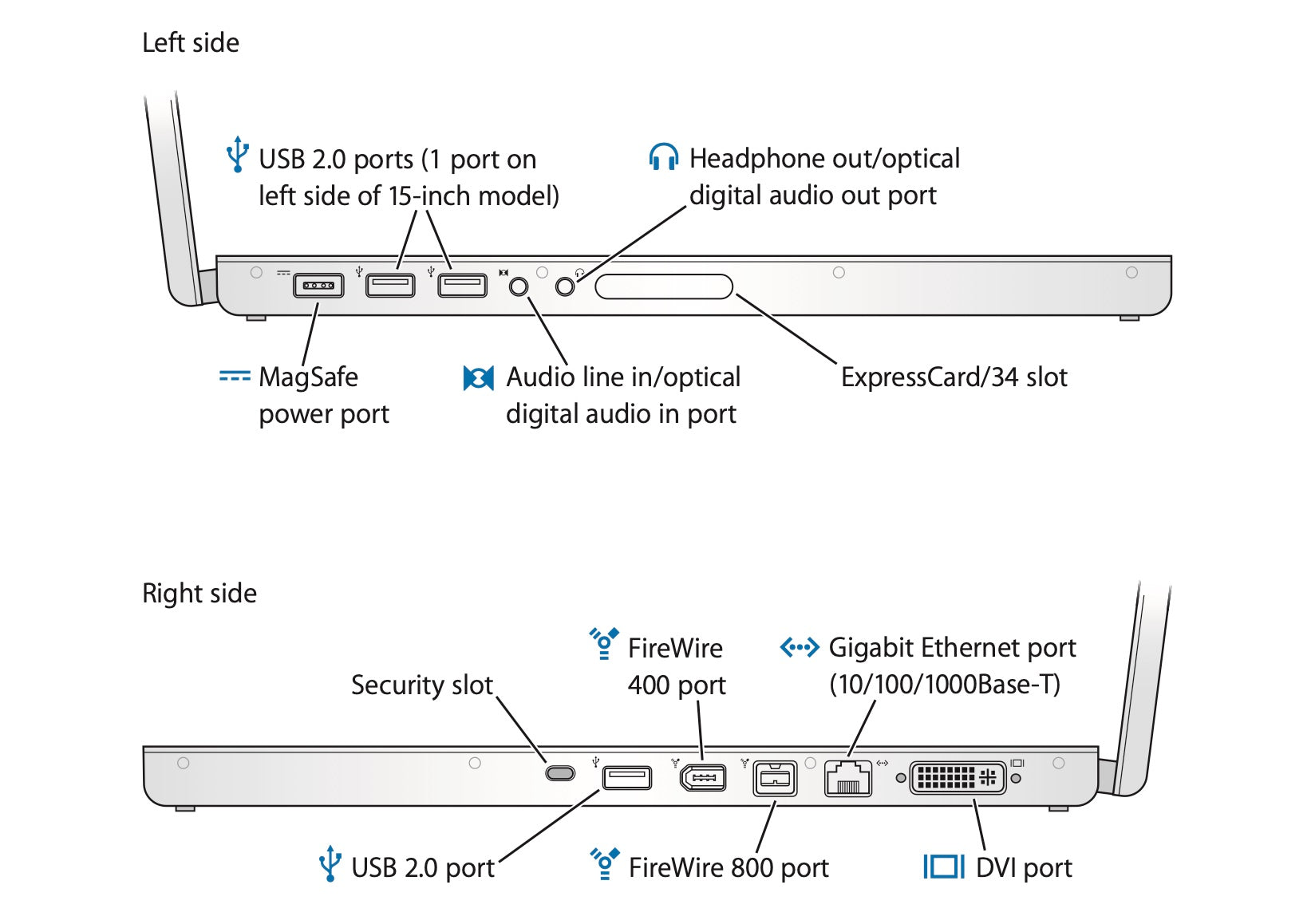
Das MacBook 2008 hat Dutzende von Anschlüssen. Wie Sie sehen können, ist die Seite des Notebooks mit verschiedenen Anschlüssen bedeckt. Offensichtlich gibt es MagSafe zum Aufladen, Gigabit Ethernet für den kabelgebundenen Internetzugang, Mini DVI für den Anschluss an externe Monitore, FireWire 400 und USB 2.0 für die Datenübertragung und vieles mehr. Bei so vielen Anschlüssen, die gleichzeitig funktionieren, ist ein dickes, sperriges Notebook-Gehäuse natürlich unvermeidlich.
Aber bedenken Sie, dass Apple das erste Unternehmen ist, das den Kopfhöreranschluss entfernt hat. Mit so vielen eingebauten Anschlüssen an der Seite ist es definitiv nicht ästhetisch ansprechend. Daher wurde der Mini-DVI-Anschluss unmittelbar nach dem Erscheinen des kleineren Mini-DP-Anschlusses ersetzt - und dieser kann ebenfalls Videos übertragen und ist mit einer besseren Leistung ausgestattet.
Dadurch wird jedoch nur die Schnittstelle für Videos etwas kleiner. Wie kann man den Rest der Benutzeroberfläche optimieren? Da kam Intel mit seiner inspirierenden Light Peak-Technologie ins Spiel.
Der Thunderbolt der ersten Generation und der Mini DP
Im Jahr 2009 stellte Intel erstmals seine neue Light-Peak-Technologie vor. Die Technologie wurde offiziell als Thunderbolt bezeichnet und kam 2011 in den Handel. Das Thunderbolt-Protokoll hatte ursprünglich das gleiche Aussehen wie der Mini DP-Anschluss und wurde 2011 sofort mit dem MacBook ausgeliefert und ersetzte den Mini DP-Anschluss von 2010. Sowohl Mini DP-Kabel als auch -Adapter können auch mit Thunderbolt-Anschlüssen verwendet werden.
Die Thunderbolt-Technologie unterstützt sowohl Daten als auch Video, d. h., sie kann Daten, Video- und Audiosignale über ein einziges Kabel übertragen und sogar Peripheriegeräte mit Strom versorgen. Die Spezifikationen der ursprünglichen Thunderbolt-Technologie lauten wie folgt:
- Hochgeschwindigkeitsübertragung: Thunderbolt bietet eine Hochgeschwindigkeits-Zweikanalübertragung mit bis zu 10 Gbps pro Sekunde.
- 2K-Video: Unterstützt einen externen 2560x1600@60Hz Bildschirm.
- Stromversorgung: Kann bis zu 10 W Leistung für Peripheriegeräte bereitstellen.
- Kompatibilität: Es kann eine Vielzahl von Adaptern entwickelt werden, die verschiedene periphere Schnittstellen wie USB, DVI, HDMI usw. unterstützen.
Wie schnell ist 10Gbps? Mit 10 Gbps kann ein FullHD-Film theoretisch in nur 30 Sekunden kopiert werden. Das ist 20 Mal schneller als das USB 2.0-Protokoll aus demselben Zeitraum.

(Obwohl die Anschlüsse die gleichen sind, hat Thunderbolt ein blitzförmiges Logo).
Die neuen Anschlüsse sind zwar extrem leistungsfähig, aber man sieht, dass das MacBook Pro 2011 nicht weniger oder dünnere Anschlüsse hat. Tatsächlich ist die Thunderbolt-Technologie so innovativ, dass sie sich nicht durchsetzen konnte. Damals war USB-A der vorherrschende Anschluss und gängige Geräte wie Mäuse, Tastaturen und USB-Laufwerke nutzten USB-A-Anschlüsse, sodass Apple nicht sofort alle häufig genutzten USB-A-Anschlüsse am MacBook eliminieren konnte.
Thunderbolt 2: Leistungssteigerung
Im Jahr 2013 führte Intel die zweite Generation der Thunderbolt-Technologie ein, die als Thunderbolt 2 bekannt ist. Die Schnittstelle hat immer noch die gleiche Form wie der Mini DP, ist aber mit einer verbesserten Leistung ausgestattet:
- Die Datenmenge pro Kanal hat sich auf 20 Gbit/s verdoppelt.
- Unterstützung des externen Anschlusses eines 4K@60Hz-Bildschirms oder zweier 2K@60Hz-Bildschirme

Apple war natürlich das erste Unternehmen, das diese Technologie übernommen hat und 2013 Thunderbolt 2 für das MacBook Pro anbot. Wie Sie sehen können, ist die Seite des MacBook Pro von 2013 viel sauberer, aber mit der Popularität von Wi-Fi und der Veralterung der Firewire-Anschlüsse wurden der Ethernet-Anschluss und der Firewire-Anschluss gründlich eliminiert. Die Anzahl der Thunderbolt 2-Anschlüsse wurde auf zwei erhöht, während der reguläre USB-Anschluss weiterhin vorhanden ist.

Das MacBook Air, das im selben Jahr auf den Markt kam, war seinerzeit ein großer Erfolg für sein ultradünnes Gehäuse, was bedeutet, dass auch die Konfiguration der Anschlüsse einfacher geworden ist. Aufgrund der Bedeutung bestimmter Anschlüsse hat Apple jedoch einen Thunderbolt 2-Anschluss und zwei USB 3-Anschlüsse beibehalten.

Als Zeichen für Apples Besessenheit von dieser Technologie war der Mac Pro, Apples fortschrittlichste Desktop-Workstation zu dieser Zeit, mit sechs Thunderbolt 2-Anschlüssen ausgestattet. Jeder MAC, der zwischen 2013 und 2015 auf den Markt kam, war mit einem Thunderbolt 2-Anschluss ausgestattet, bis Thunderbolt 3 aufkam.
Thunderbolt 3 mit USB-C der nächsten Generation
Ende 2015 erhielt die Thunderbolt-Technologie ein weiteres Upgrade, das eng mit USB-C verbunden war. Der USB-C-Anschluss ist klein genug, um auf ein dünnes Gerät zu passen und kann ohne Unterschied in beide Richtungen eingesteckt werden. Er kann auch Protokolle für Daten, Video und Stromversorgung gleichzeitig übertragen. Ein einziges USB-C-Kabel kann die gesamte Arbeit erledigen, weshalb es damals sehr begrüßt wurde und langsam an Popularität gewann.
Die Popularität von USB-C ist eigentlich der größte Vorteil. Der Mini DP konnte sich viele Jahre lang nicht durchsetzen und war nur bei einer Handvoll Laptop-Marken zu finden, doch USB-C wurde weithin anerkannt und akzeptiert. Das ist der Grund, warum Thunderbolt 3, das 2015 veröffentlicht wurde, USB-C als bevorzugten Träger gewählt hat.

Im Jahr 2016 ließ Apple beim neuen MacBook Pro alle üblichen Anschlüsse weg und behielt nur den fortschrittlichen USB-C-Anschluss mit Thunderbolt 3-Stromversorgung bei. Dieser radikale Schritt sorgte für große Kontroversen, da die USB-C-Schnittstelle nicht weit verbreitet war und viele Medien Verwirrung und Verärgerung zum Ausdruck brachten - Mäuse, Tastaturen, Monitore und SD-Karten waren nicht mehr nutzbar und erforderten den Kauf von verschiedenen Adaptern, um externe Geräte weiterhin normal nutzen zu können.
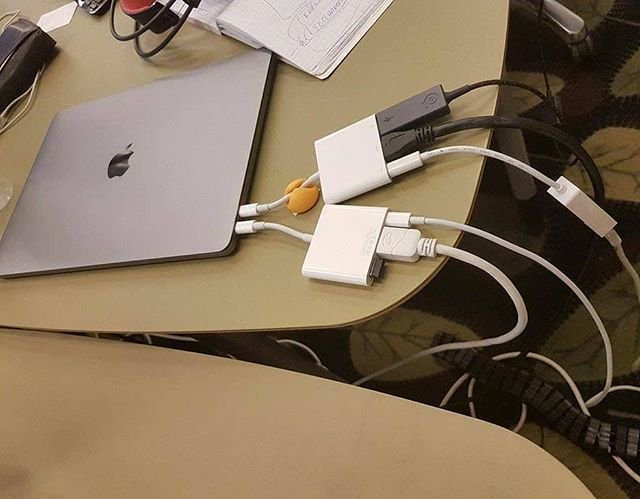
(Bis heute werden MacBook Pro-Besitzer die Angst nicht los, von den verschiedenen Adaptern dominiert zu werden).
Die Kühnheit von Apple beruht natürlich auf dem Glauben an die Leistungsfähigkeit der Thunderbolt 3 Schnittstelle:
- Datenübertragungsgeschwindigkeiten von bis zu 40 Gbps, doppelt so schnell wie bei der vorherigen Generation.
- Unterstützt einen externen 5K@60Hz Monitor oder zwei 4K@60Hz Monitore.
- Unterstützt USB-PD-Stromversorgung mit bis zu 100 W
Was bedeutet 40Gbps? Das Kopieren von 25.000 Fotos dauert weniger als eine Minute. Mit einer Ladeleistung von 100 W war es mehr als genug, um selbst das damals leistungsstärkste 15-Zoll-MacBook Pro zu laden. Mit der Leistung von Thunderbolt 3 und USB-C können all diese Funktionen über ein einziges Kabel ausgeführt werden.
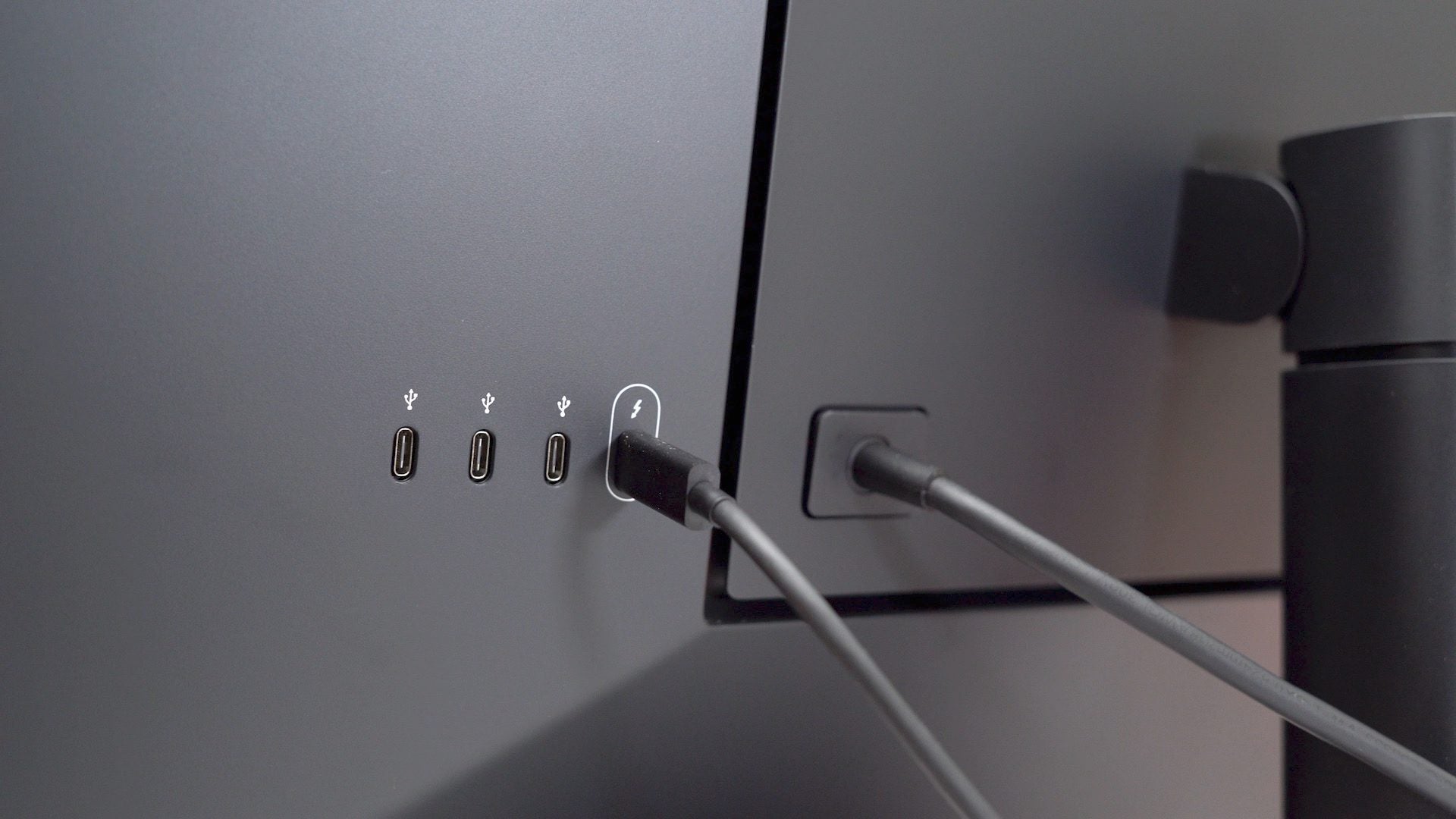
In Zusammenarbeit mit LG hat Apple außerdem das Thunderbolt Display vorgestellt, das nur eine Thunderbolt 3 Kabelverbindung benötigt, um Bilder zu übertragen und gleichzeitig den Laptop aufzuladen, was es zu einer perfekten Ergänzung für das neue MacBook Pro mit einem aufgeräumten Schreibtisch ohne Kabelsalat macht.
Das hört sich wirklich toll an, oder? Aber hier ist das Problem: Der Thunderbolt 3-Anschluss ist so hochwertig, dass der durchschnittliche Verbraucher ihn nicht täglich nutzen kann - würden Sie 25.000 Fotos auf einmal kopieren? Wann haben Sie das letzte Mal etwas kopiert? Außerdem kaufen viele Leute Laptops wegen ihrer Leichtigkeit und Mobilität, und nicht jeder wird einen externen Monitor anschließen wollen. Und wie viele von ihnen werden zwei High-End-4K-Monitore anschließen wollen?
Aus diesem Grund gibt es auch heute noch viele Menschen, die nicht wirklich wissen, was Thunderbolt ist, obwohl der Laptop, den sie verwenden, mit Thunderbolt ausgestattet ist.

Thunderbolt 3 richtet sich trotz all seiner Vorteile an professionelle Nutzer, und das ist genau das, was das MacBook Pro anstrebt. Zum Beispiel haben professionelle Nutzer, die sich mit Design, Fotografie, Videobearbeitung und anderen kreativen Arbeiten beschäftigen, oft Hunderte von GB an Dateien zu verwalten, und natürlich brauchen sie eine schnellere Übertragung, um die Effizienz zu verbessern, und sie brauchen auch hochauflösende 4K-Displays, bequem für sie zu schneiden, Farbe, und so weiter.
Der durchschnittliche Benutzer kann einfach nicht die volle Leistung der Thunderbolt-Technologie nutzen. Glücklicherweise verwendet Thunderbolt 3 USB-C als Träger und ist mit anderen USB-C-Protokollen kompatibel, sodass es immer noch einige sehr praktische Anforderungen erfüllen kann, wie z. B.:
- Der Laptop-Bildschirm ist zu klein und ich möchte ihn auf einen größeren Bildschirm/Fernseher projizieren.
- Schließen Sie Ihren Laptop an den Projektor an, wenn Sie eine Präsentation im Büro oder in der Schule halten.
Allerdings benötigen Sie Adapter, um die oben genannten Anforderungen zu erfüllen. Es gibt eine schwindelerregende Anzahl von Adaptern auf dem Markt, die Ihnen helfen können, frei zwischen USB-C und einer Vielzahl von Anschlüssen zu wechseln, und egal, wie alt Ihr Monitor, Fernseher oder sogar Projektor ist, Sie können immer einen finden, der für Sie funktioniert. Am Ende dieses Artikels werden wir auch einige häufig verwendete Adapter empfehlen.
Thunderbolt 4: Keine große Verbesserung?
Im Jahr 2020 kündigte Intel an, dass alle PCs mit Intel Core-Prozessoren der 11. Generation (Codename Tiger Lake) mit Thunderbolt 4-Anschlüssen ausgestattet werden. Thunderbolt 4 sieht auf dem Papier nicht viel anders aus als sein Vorgänger, mit 40 Gbps Bandbreite und 100W Leistung, wahrscheinlich weil Intel davon ausgeht, dass Thunderbolt 3 bereits leistungsstark genug ist.
Die Upgrades von Thunderbolt 4 konzentrieren sich auf die folgenden Aspekte:
- Die minimalen PCIe-Datenanforderungen wurden von 16 Gbps auf 32 Gbps erhöht. Dies bedeutet, dass externe Hochgeschwindigkeits-PCIe-Geräte wie externe Speicher und externe Grafikkarten eine bessere Leistung haben werden.
- Unterstützt einen externen 8K@60Hz Monitor oder zwei 4K@60Hz Monitore.
- Erstmals wird auch das längste Datenkabel mit 2 Metern Länge unterstützt.
- Unterstützung für Konnektivitätszubehör mit bis zu vier voll funktionsfähigen und hochflexiblen Thunderbolt-Downstream-Anschlüssen. Die Vorgängergeneration konnte auf zwei skaliert werden, was bedeutet, dass der Thunderbolt 4 mit mehr Geräten gleichzeitig verbunden werden kann.
- Laptops, die weniger als 100 Watt zum Laden benötigen, müssen an mindestens einem ihrer Thunderbolt 4-Anschlüsse USB Typ-C-Ladefunktionen bieten.
- Nach dem Anschluss an ein Thunderbolt 4-Dock kann der Computer durch Berühren der Tastatur oder Maus aus dem Ruhezustand aufgeweckt werden.
Einfach ausgedrückt ist Thunderbolt 4 eine eingeschränktere Version von Thunderbolt 3 mit höheren Leistungsgrenzen und erweiterter Funktionalität. Es definiert strenge Produktmerkmale, Validierungstests und Zertifizierungsanforderungen, sodass Geräte, die Thunderbolt 4 unterstützen, ein besseres Erlebnis bieten und natürlich auch teurer sind. Allerdings ist Thunderbolt 4 erst seit fast einem Jahr auf dem Markt, und es ist noch ein weiter Weg bis zur Popularität, also machen Sie sich nicht zu viele Sorgen.
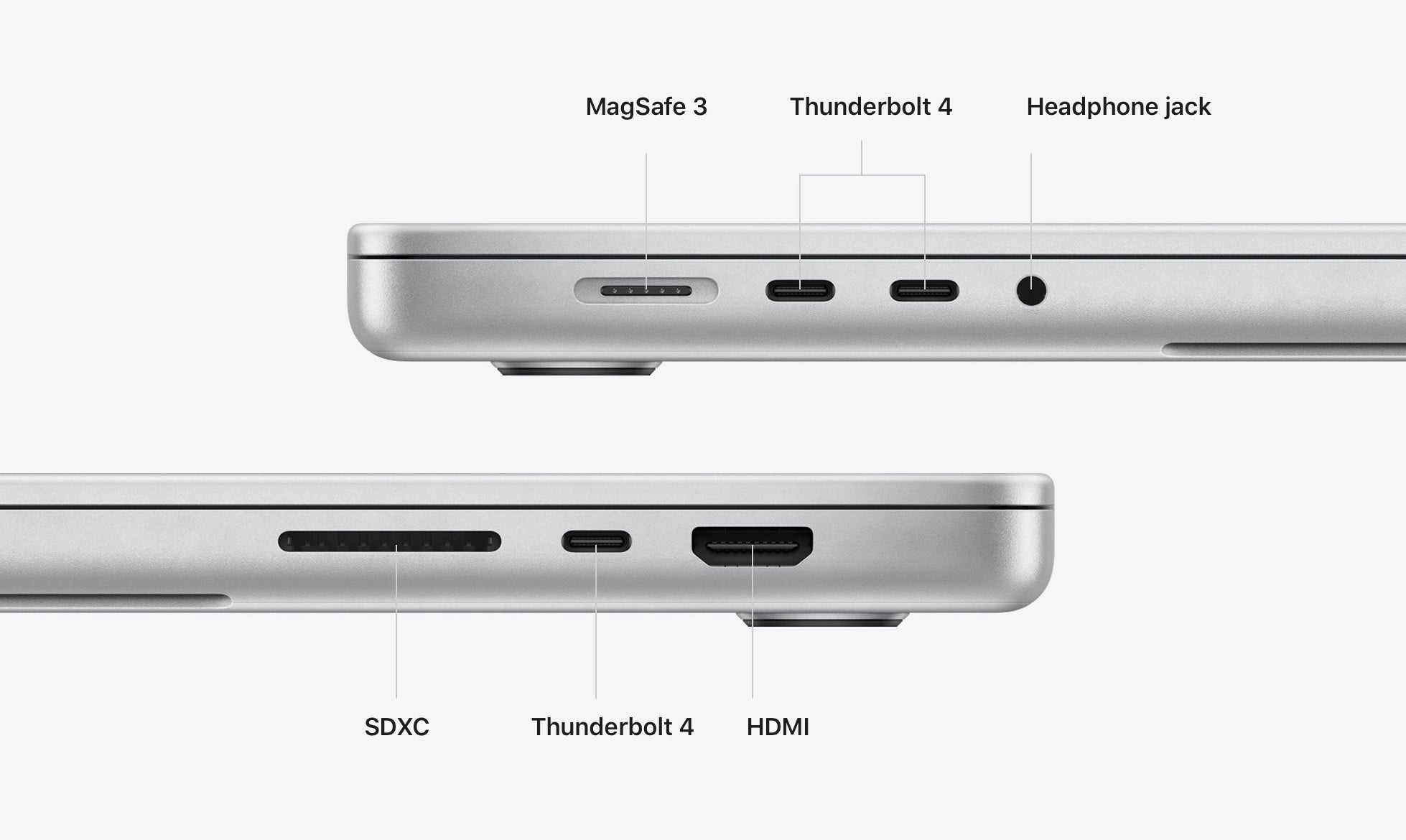
(Apple lieferte bis zu drei Thunder 4-Anschlüsse für sein neuestes MacBook Pro im Jahr 2021).
Habe ich Thunderbolt auf meinem Laptop?
Der erste Schritt ist ein Blick auf die Form. Wenn die Schnittstelle die Form eines Mini DP hat, handelt es sich möglicherweise um eine Lightning-Schnittstelle der ersten oder zweiten Generation. Wenn der Anschluss die Form eines USB-C hat, könnte es sich um einen Lightning-Anschluss der dritten oder vierten Generation handeln.
Im zweiten Schritt wird geprüft, ob sich in der Nähe der Schnittstelle ein Logo in Form eines Blitzes befindet.
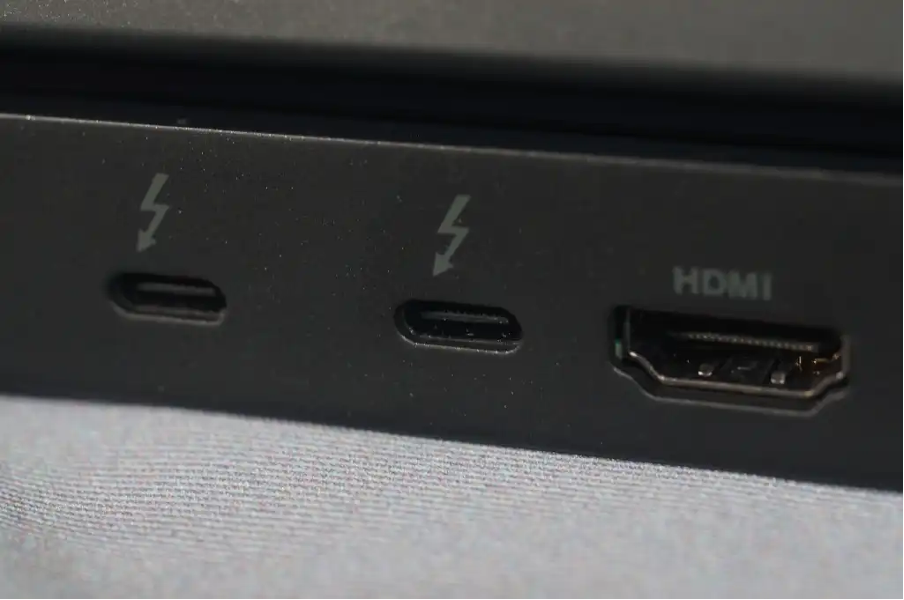
Wenn die obigen zwei Schritte Ihnen immer noch nicht helfen, die Version zu bestätigen, ist der genaueste Weg, das offizielle Dokument mit den technischen Spezifikationen zu konsultieren, das normalerweise auf der offiziellen Website verfügbar ist. Bei Apple zum Beispiel gibt es eine spezielle Seite, die Ihnen hilft, die Version der Lightning-Schnittstelle Ihres Geräts zu bestimmen: https://support.apple.com/en-us/HT201736
So nutzen Sie Thunderbolt
Thunderbolt 3 verwendet USB-C-Anschlüsse, sodass die USB-C-Funktionen gut erhalten bleiben. Die folgenden Szenarien sind sehr gut für die Leistung der Thunder 3-Schnittstelle geeignet:
- Externer Hochgeschwindigkeits-Speicher auf Thunderbolt-Basis
- Externe Grafikkarten
- Anschluss von hochauflösenden Monitoren
- Leistungsstarke Vernetzung
Wenn Sie nur eines dieser Szenarien wünschen, kaufen Sie ein Thunderbolt-Kabel, das mit Ihrem Gerät kompatibel ist. Für einen Laptop mit einem Thunderbolt 3-Anschluss können Sie beispielsweise ein Thunderbolt 3-Kabel oder ein Thunderbolt 4-Kabel kaufen, das abwärtskompatibel ist. Es ist auch sehr einfach, zwischen den beiden zu unterscheiden: Der Anschluss eines Thunderbolt-Kabels ist mit dem Lightning-Logo bedruckt und mit der Zahl "3" oder "4" gekennzeichnet, um anzuzeigen, ob es sich um ein Thunderbolt-3- oder Thunderbolt-4-Kabel handelt.

Wenn Sie jedoch ein professioneller Benutzer sind, der alle oben genannten Szenarien benötigt oder mehr Anschlüsse für Ihre Peripheriegeräte wünscht, dann ist eine Dockingstation die beste Wahl. Dennoch sind Thunderbolt-Docks in der Regel teuer, ganz zu schweigen von der Tatsache, dass es eine Reihe von optionalen Spezifikationen zur Auswahl gibt. Daher wäre es etwas unklug, ein Produkt zu kaufen, das nicht den eigenen Bedürfnissen entspricht. In unserem nächsten Blogbeitrag erfahren Sie, wie Sie die richtige Dockingstation für sich finden.
Aber wenn Sie ein Apple-Benutzer mit einem 2016-2020 MacBook Pro sind, ist die iVANKY Docking Station Pro, die für das MacBook Pro optimiert ist, die richtige Wahl. Es ist kein Thunderbolt 3-Dock, aber der duale USB-C-Anschluss, der für das MacBook Pro entwickelt wurde, bietet die gleiche Leistung zu einem viel besseren Preis. Klicken Sie auf das Bild unten, um mehr zu erfahren.
Verwandte Produkte



